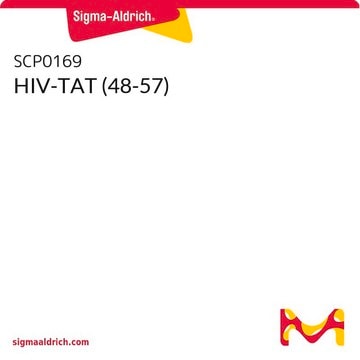H0292
HIV-1 Tat Peptide
≥97% (HPLC), lyophilized powder
About This Item
Polecane produkty
product name
HIV-1 Tat Protein (47-57),
pochodzenie biologiczne
synthetic
Poziom jakości
Postać
lyophilized powder
rozpuszczalność
deionized water: soluble
Warunki transportu
dry ice
temp. przechowywania
−20°C
ciąg SMILES
NCCCC[C@H](NC(=O)[C@H](CCCNC(N)=N)NC(=O)CNC(=O)[C@@H](N)Cc1ccc(O)cc1)C(=O)N[C@@H](CCCCN)C(=O)N[C@@H](CCCNC(N)=N)C(=O)N[C@@H](CCCNC(N)=N)C(=O)N[C@@H](CCC(N)=O)C(=O)N[C@@H](CCCNC(N)=N)C(=O)N[C@@H](CCCNC(N)=N)C(=O)N[C@@H](CCCNC(N)=N)C(O)=O
InChI
1S/C64H118N32O14/c65-25-3-1-11-39(89-50(101)38(13-5-27-81-59(69)70)88-48(99)34-87-49(100)37(67)33-35-19-21-36(97)22-20-35)51(102)90-40(12-2-4-26-66)52(103)91-41(14-6-28-82-60(71)72)53(104)92-43(16-8-30-84-62(75)76)55(106)95-45(23-24-47(68)98)57(108)94-42(15-7-29-83-61(73)74)54(105)93-44(17-9-31-85-63(77)78)56(107)96-46(58(109)110)18-10-32-86-64(79)80/h19-22,37-46,97H,1-18,23-34,65-67H2,(H2,68,98)(H,87,100)(H,88,99)(H,89,101)(H,90,102)(H,91,103)(H,92,104)(H,93,105)(H,94,108)(H,95,106)(H,96,107)(H,109,110)(H4,69,70,81)(H4,71,72,82)(H4,73,74,83)(H4,75,76,84)(H4,77,78,85)(H4,79,80,86)/t37-,38-,39-,40-,41-,42-,43-,44-,45-,46-/m0/s1
Klucz InChI
RAVVEEJGALCVIN-AGVBWZICSA-N
Amino Acid Sequence
Opis ogólny
Działania biochem./fizjol.
Postać fizyczna
Inne uwagi
Kod klasy składowania
11 - Combustible Solids
Klasa zagrożenia wodnego (WGK)
nwg
Temperatura zapłonu (°F)
Not applicable
Temperatura zapłonu (°C)
Not applicable
Certyfikaty analizy (CoA)
Poszukaj Certyfikaty analizy (CoA), wpisując numer partii/serii produktów. Numery serii i partii można znaleźć na etykiecie produktu po słowach „seria” lub „partia”.
Masz już ten produkt?
Dokumenty związane z niedawno zakupionymi produktami zostały zamieszczone w Bibliotece dokumentów.
Klienci oglądali również te produkty
Nasz zespół naukowców ma doświadczenie we wszystkich obszarach badań, w tym w naukach przyrodniczych, materiałoznawstwie, syntezie chemicznej, chromatografii, analityce i wielu innych dziedzinach.
Skontaktuj się z zespołem ds. pomocy technicznej










